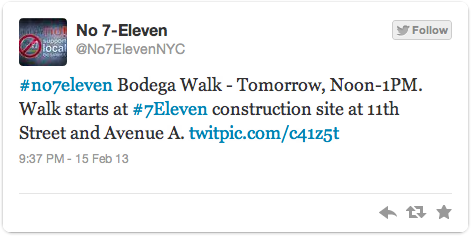There was another bodega walk this past Saturday.
By the looks of their photos though, it wasn’t well attended.
Here is a flyer they typed up. I’m only going to address a few of their claims.
(I left in the line about the free market because it’s funny. East Villagers, Unite! Defend the Free Market!)
It makes no sense to describe the East Village as having its own economy. There is no East Village industry, there are no East Village exports. Bodegas do not create a net inflow of capital (i.e., money is not coming into the East Village because of bodegas). The people of this area do not depend on the bodegas for their livelihood. If this were Pittsburgh and the steel mills were closing, it would be a different story. Rather than complain about which stores are opening, it would be better to limit the number and locations of all stores. Rather than view the area as an enterprise zone, it should be viewed as a neighborhood.
Whenever the phrase “the economy” is used, what is meant is profits — and in this case, it’s not even gross profits, it’s the Owner Class’s share of those profits. If one 7‑Eleven displaces one bodega, the net effect is zero, all else being equal. The revenue that went to the bodega now goes to the 7‑Eleven. If that was $10,000/month, it stays $10,000/month. The difference exists in how much of this remains with the owner. The bodega owner would have kept the entire $10,000, but the 7‑Eleven owner must send 50% of it to the corporate office, so he keeps only $5,000. So some of the profits do leave the area. But they don’t consider the effect on a particular owner, since the owner’s salary might be an increase for him. They only consider the effect to the Owner Class: Owner A receives $10,000, Owner B receives $5,000, net effect to Owner Class: -$5,000.
Now we need to look at the number of people working at each location. For my calculations, I use the likely-minimum number of workers. (My research indicates a minimum of two workers per bodega. According to Entrepreneur.com, the number of employees needed to run a 7‑Eleven is seven to ten.)
| Bodega | 7-Eleven | |
| Profits/mo: | $10,000 | **$5,000 |
| Wages/mo. – 2 empl.* | 2,320 | |
| Wages/mo. – 7 empl.* | 8,120 | |
| _____ | _____ | |
| Total Income | $12,320 | $13,120 |
| *$7.25/hr x 40 hrs | ||
| **1/2 goes to corporate hq | ||
| . |
So with sales held constant, and the minimum number of workers employed, a 7‑Eleven raises the income of the neighborhood.
Equally ludicrous is the claim that 7‑Eleven has an unfair advantage over local businesses by being exempt from the >16-ounce soda ban. The only businesses in the neighborhood affected by the “soda ban” are restaurants and movie theaters, neither of which compete with 7‑Eleven. Mind you, Slurpees® are probably disgusting (I’ve never had one), and I don’t encourage anyone to drink them, and they should be regulated by the ban, but they do not give the 7‑Eleven an unfair advantage.
As far as homogenizing the neighborhood? That happened a long time ago.


Mar 08, 2013 @ 18:23:44
Nice. Very effective post.